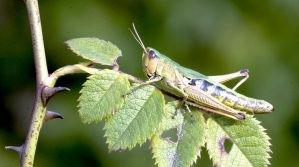
Grasshoppers - the chirpy chappies of the Forest
Few sounds are more evocative of summer than a grasshopper chirruping in a woodland glade, but apart from their distinctive song, what else do we know about these elusive insects?
Just not crickets!
Plentiful at this time of year across the Heart of England Forest, grasshoppers are just one of the 27 species of the order of Orthoptera (meaning ‘straight wings’) native to the UK. While the order includes crickets and locusts, grasshoppers shouldn’t be confused with either! All locusts are grasshoppers, but not all grasshoppers are locusts. In fact, locusts and grasshoppers behave in a different way. Unlike grasshoppers, locusts are known for their density-dependent behaviour, often swarming in large groups. This act of swarming is the most notable and obvious characteristic that identifies a locust as a subspecies of the grasshopper.
Both crickets and grasshoppers are noted for the distinctive sound, or song, they emit. Crickets are usually more active at night than grasshoppers, who love sunbathing, and both employ different techniques to make their song, known as stridulation, as part of their courtship routine. They can produce up to five different songs during the different stages of courtship. While grasshoppers rub their legs against their wings and, oddly enough, have ‘ears’ in their bottoms, crickets ‘stridulate’ by rubbing their legs together and hear through ear-like sensors on their front legs!
Telling grasshoppers from crickets is relatively simple – crickets usually tend to have long antennae, while those of the grasshopper are shorter.
A sun-seeking species
The most common species of grasshopper likely to be found in the Heart of England Forest are the field grasshopper, the common green grasshopper and the meadow grasshopper. The former likes short grassy spots where it can bask in the warm summer sun. Usually around 15-19mm in length, its wings extend the whole length of its body and it can be identified by the zig-zag marking behind its head. Most commonly seen in early summer (although in warm years they have been seen as late as December) it can be found in a variety of colours, including pink, brown, green and even purple.
The common green grasshopper is a similar size to the field grasshopper and is so named because the female is predominantly green in colour; the males is sometimes a more olive-brown. These winged grasshoppers are consummate fliers although their wings never exceed the end of their bodies. Adults are most abundant during July and can survive until November, favouring parkland, meadows and woodland rides.
Meanwhile, the meadow grasshopper is the smallest of the three, measuring around 10-16mm and preferring to alight on taller vegetation. Its wings are shorter and rarely extend beyond the body and it is usually brown or green, although they have occasionally been found resplendent in pink! Usually seen between June and September, the meadow grasshopper is the only species that cannot fly, while other grasshoppers use their powerful legs to propel them into flight.
Hunter and hunted
Grasshoppers feed on plants in the grass family, such as corn, wheat and barley, so it’s not uncommon to find them on the margins of crop fields. They also eat many other types of plants and can be found chewing on the leaves of a tree or eating the grass beneath it.
In turn, they are popular prey for a variety of animals and birds. Rodents such as mice or rats feed on them, as do many birds, spiders and reptiles, and they are also a favourite meal for amphibians such as frogs and toads.
In parts of the world locusts have a partially deserved reputation as pests who, when they are present in large numbers, can destroy crops. However, grasshoppers do play an important role in the ecosystem of the Forest, providing an essential food supply for many predators. Without them a vital constituent of the ecosystem would disappear, making many other species vulnerable. Besides, who can argue that their unique sounds do not add more than a little allure to the woodland symphony?



